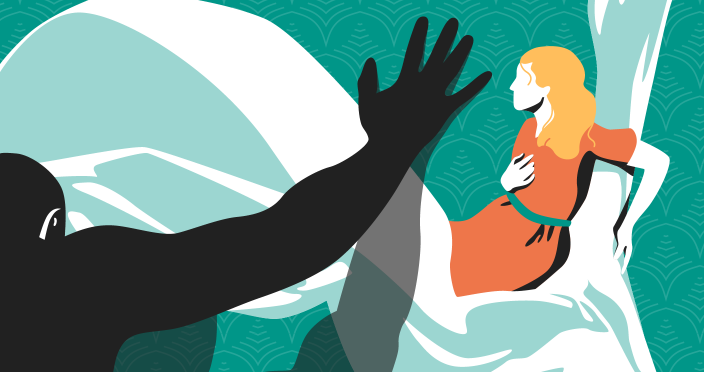Symbols in Othello, such as the handkerchief, the Willow Song, the candle, and the Moon, are crucial for understanding the play. Othello’s symbolism helps deepen the story’s themes of jealousy, trust, and manipulation, meanwhile enhancing its emotional impact. Shakespeare uses familiar signs and objects in unconventional, often unexpected ways, adding extra depth for both the play’s readers and spectators.
In this guide, you’ll find:
- Symbols and motifs in Othello explained
- The play’s literary analysis with a special focus on allusions and irony
- Imagery in Othello broken down
Let’s start our journey into a captivating world of symbolism in Othello by William Shakespeare!
✨ Othello Symbols
There are a lot of secondary symbols in Othello. It is crucial to analyze them as well to get a full understanding of the play.
Handkerchief in Othello

In Othello, the handkerchief, which Othello presents to Desdemona, serves as a significant symbol. It bears a lot of importance due to its origin and the meaning that Othello attaches to it.
Othello gives the handkerchief as “a token of love,” therefore, for him, it serves as proof of mutual belonging to one another. However, at some point in the play, the symbol of love becomes proof of Desdemona’s infidelity. It becomes the essence of the Shakespearean tragedy. Some critics even say that the handkerchief in Othello is the most dominant symbol in the entire play.
For the first time, this object appears in the play when Desdemona offers it to Othello, and he rejects it. Instead, he says that her “napkin is too little.” It can refer to three things. First, it can mean that Othello’s trust in Desdemona is already depleting. Also, by calling it “a napkin” instead of “a handkerchief,” Othello is belittling its importance. Third, it can mean that Othello’s fixation over the handkerchief starts with Iago turning it into proof of infidelity.
At first, the handkerchief does not seem that crucial. Its importance becomes more and more evident from the moment when Desdemona drops it. The object turns into a tool in the execution of Iago’s plan and, ultimately, into an “ocular proof” of Desdemona’s affair. The audience will see how Iago uses the handkerchief to condemn Desdemona.
After Othello’s wife drops the handkerchief, it is being passed through the hands of every central character in the play. For each person, Desdemona’s handkerchief means something:
- For Othello, the handkerchief symbolizes their marriage bond, love, and Desdemona’s purity. Later on, though, it becomes a symbol of infidelity and cuckoldry.
- For Iago, it is a symbol of the power and control he has over Desdemona and Othello.
- For Desdemona, it is a symbol of Othello’s love.
- For Bianca, it symbolizes jealousy and passion.
- For Emilia, her desire for a happy marriage and subjection to her husband.
In a way, the handkerchief becomes a shared property in the play.
When Desdemona drops the object, Emilia picks it up and gives it to Iago. She does not know why Iago wants it so much. As she says later, he asked her to steal the handkerchief at least a hundred times before.
Iago is opportunistic and changes his plan immediately after Emilia hands it to him. It shows that Iago is always one step ahead of everyone. The audience sees what Iago does with the handkerchief later on.
When Othello demands the “ocular proof,” Iago tells him that he has one. Iago mentions to Othello that he saw Cassio wiping his beard with the strawberry handkerchief without being conspicuous. For Othello, it can mean only one thing. If his wife offered their “token of love” to Cassio, she probably offered her body to him as well. At that moment, Othello calls for blood and revenge.
The audience understands that for Othello, the handkerchief means more than it means for Desdemona. Her primary focus is Othello, and she does not need any external affirmation of their love for one another.
At the same time, Othello misplaces his love for Desdemona, and the object that supposes to represent their love becomes the proof of love itself in Othello’s mind. The strawberries that used to symbolize Desdemona’s virginity now serve as a symbol of her whoredom.
Two Stories of One Handkerchief
Othello gives two different stories about the origin of the handkerchief. He claims that an Egyptian gave it to his mother. He states:
She told her, while she kept it
Othello, Othello, Act 3, Scene 4
‘Twould make her amiable and subdue my father
Entirely to her love, but if she lost it
Or made gift of it, my father’s eye
Should hold her loathèd and his spirits should hunt.
He believes that his mother used the handkerchief to control her husband, Othello’s father. She may have been so afraid to lose it because it would mean an end to their marriage.
Othello most probably made up this version of the origin of the handkerchief to test Desdemona. He wants his wife to tell him the truth about the whereabouts of the personal object. Desdemona is bothered by the story and lies to Othello for the first time. She says that the handkerchief is still with her.
In European Medieval Literature, a handkerchief is a symbol of female favor. For Desdemona, it serves as a symbol of Othello’s love for her. However, usually, it would be a female who would give a handkerchief to the man she loves.
The audience gets two versions of what, according to Othello, is the history of the handkerchief. In Othello’s second story of how he got it, he says that his father had given it to his mother to prove his love. While earlier, he was telling that an Egyptian charmer had presented it to his mother.
After that, the couple never talks about the handkerchief until the deathbed scene. Being confronted by Othello, Desdemona explains that Cassio:
Found it, then.
Othello, Desdemona, Act 5, Scene 2
I never gave it to him.
She did not lose the handkerchief, nor she gave it away.
Obviously, both stories cannot be accurate. Most probably, the second story is true. However, Othello’s attitude towards the handkerchief changed. He started believing that it has some magic powers.
In the beginning, when Desdemona offers the handkerchief to Othello, he rejects it. It shows that he does not think it has any magic powers. Later on, he believes that it is a charm against adultery. The transformation of the symbolic meaning of the handkerchief causes the shift of the story behind it.
Handkerchief as an Ocular Proof
As the handkerchief passes from person to person, Othello’s suspicions grow. Ultimately, for Othello, it served as proof of Desdemona’s purity. Therefore, every time he sees it in someone else’s hands, her innocence becomes compromised.
The path of the handkerchief in Othello starts before the audience sees Othello and Desdemona. It is a part of their “backstory.” It turns into a visual representation of their love, then into ocular proof of Desdemona’s infidelity, and in the end, it becomes the evidence of Iago’s manipulation.
When Bianca finds the handkerchief, Cassio asks her to make a copy of its embroidery. Shakespeare uses irony in this scene to show that it, in fact, does not mean anything.
When Othello sees the handkerchief in Bianca’s hands later on in the play, it means only one thing for him. He believes Iago wholeheartedly. Thus, the ocular proof is found.
The Willow Song in Othello

The Willow Song is one of the essential symbols in Othello. It’s a song that Desdemona recalls in Act 4 Scene 3. It was originally sung by her mother’s servant, Barbara.
Just a few moments before Desdemona dies, while she prepares to go to sleep, she mentions The Willow Song to Emilia. She tells the story behind it and sings it. Desdemona states that this song was on her mind all night long. However, she feels free to say this only in private.
Desdemona talks to Emilia about the significance of The Willow Song while they are changing the bedsheets. Desdemona asks her servant to put her wedding sheets on, then suddenly she adds that she wants to be buried covered in her wedding sheets.
Many critics were wondering what the effect of The Willow Song and the interruptions to it is. With its constant interruptions and pauses, it sounds more like a cry of Desdemona about her lost love. The constant inclusion of the line, “sing willow, willow, willow,” gives an idea of how fragmented Desdemona’s memories and thinking are at night before her death.
Barbara, her mother’s servant, was also left by her lover, as he went mad and abandoned her. She says:
she was in love, and he she lov’d prov’d mad,
Othello, Desdemona, Act 4, Scene 3
And did forsake her: she had a song of ‘willow,’
An old thing ’twas, but it express’d her fortune,
And she died singing it.
As a result of this betrayal, Barbara died heartbroken while singing The Willow Song.
Just like “poor Barbary,” Desdemona sings the song about her sad destiny, which she chooses to accept but hopes to change. That is why she requests the bedding to be changed.
In Othello, The Willow Song becomes a swansong for Desdemona and Emilia since both will sing it just before dying. It ties all three females together: Barbary, the servant, Desdemona, and Emilia, another servant. The song goes,
The poor soul sat sighing by a sycamore tree
Othello, Desdemona, Act 4, Scene 3
Sing all a green willow.
Her hand on her bosom, her head on her knee
Sing willow, willow, willow.
The fresh streams ran by her, and murmer’d her moans
Sing willow, willow, willow;
Her salt tears fell from her and soft’ned the stones.
Sing willow, willow, willow.
Sing all a green willow must be my garland.
Let nobody blame him, his scorn I approve
He was born to be fair, I to die for his love,
I call’d my love false love but what said he then?
Sing willow, willow, willow.
If I court more women, you’ll couch with more men
The Willow Song in Othello represents many things. It symbolizes the tragic destiny of a woman that has to live in a male-dominated society. It reveals her loneliness and acceptance of her fate, betrayal and hurt.
The earliest known version of this song dates to the end of the 15th century. However, traditionally it is very different from the one Shakespeare incorporated into Othello.
The major transformation of the song is connected with gender. In the original version, the song is about a man who is betrayed by his lover. Shakespeare adjusted the verses to fit Desdemona’s gender and tragic circumstances.
In Desdemona’s song, Shakespeare also alters the words and includes lines. For instance, Desdemona misremembers the line:
Let nobody blame him; his scorn I approve.
Othello, Desdemona, Act 4, Scene 3
This phrase later parallels Desdemona’s final words:
Nobody, I myself. Farewell.
Othello, Desdemona, Act 5, Scene 2
Commend me to my kind lord. O, farewell
By asking nobody to blame Othello, she defends his abuse and forgives him freely. She chooses to remain faithful to Othello despite all the pain he causes her.
This line is the only phrase that is coming directly from Desdemona herself. The audience, which knows the original willow song, immediately recognizes this inclusion. She looks back at the scene in which Othello physically abused her and asks not to be harsh to him.
At the same time, Desdemona foreshadows that something more tragic is about to happen to her. The name “Barbara” correlates with Othello’s nickname “the barbary horse,” exposing the inner connection between these two females and their tragic lives.
The Willow Song foreshadows Emilia’s death as well. Like Barbara, Emilia is a servant, she is married to a madman, and she dies because of him.
After being stabbed by Iago, Emilia sings The Willow Song. First, as a way to remember her mistress, but also as a way to accept her female destiny. She cries out:
Willow, willow, willow. Moor, she was chaste.
Othello, Emilia, Act 5, Scene 2
She loved thee, cruel Moor.
At the end of the play, via Desdemona’s song, Emilia obtains her voice and speaks up. Her words become a continuation of The Willow Song.
The willow scene in Othello is one of the most intimate dialogues between women in Shakespeare. The friendship that two women share in the play stands in opposition to the male friendship between Iago and Othello, Othello and Cassio, Iago and Roderigo.
This scene allows both characters to express themselves freely. The fact that it is done through the song and not through a soliloquy shows that two women are still learning how to be free in a world dominated by men.
Candle as a Symbol

The candle that Othello blows out before he kills Desdemona symbolizes her life. Seconds before he smothers her, he says, “put out the light, and then put out the light.” By saying that, Othello means that he can blow the light of a candle and lit it up again. However, he cannot kill Desdemona twice: her life is too fragile and gentle.
Othello concludes:
If I quench thee, thou flaming minister,
Othello, Othello, Act 5, Scene 2
I can again thy former light restore,
Should I repent me: but once put out thy light,
Thou cunning’st pattern of excelling nature.
One of the symbols and motifs connected with the candle’s image in Othello is the symbolism of light and darkness. Shakespeare does not talk about the physical absence of light. In Othello, darkness reflects the internal qualities of the characters. No wonder Iago’s opening scene starts in darkness because it mirrors his personality.
Shakespeare created a play with a circle composition that starts and ends with the scenes in complete darkness. Othello kills Desdemona in total darkness as well. It symbolizes a shift in Othello’s personality.
Moon as Symbol

Traditionally in literary works, the moon symbolizes purity and romance. However, in Othello, the moon refers to something completely different: it brings tragedy and death.
Seconds after Othello murders Desdemona, he blames the moon for it. He says:
It is the very error of the moon;
Othello, Othello, Act 5, Scene 2
She comes more nearer earth than she is wont
And makes men mad.
Othello connects his madness with planetary proximity to the earth and its effect on him.
Some critics believe that Othello meant it in a figurative way. In fact, he was talking about the changeability and fickleness of women that drive men crazy and make them act stupid.
Wedding Sheets

The symbolism of the wedding sheets in Othello is another crucial aspect of the play. It represents Desdemona’s purity and virginity. The first wedding night between Othello and Desdemona never happened because it was constantly interrupted.
When Desdemona does not possess her handkerchief anymore, she tries to replace it with the wedding sheets to prove to Othello that she is innocent. This moment of changing the sheets in Act 4 Scene 3 resembles some sort of ritual in which sacrifice has to be made.
Othello, who is blinded and overwhelmed with anger and jealousy, does not notice her wedding sheets when he comes to kill her. Desdemona tries to present “an ocular proof” of her loyalty. However, it is too late.
Usually, wedding sheets symbolize the bride’s virginity and love between the newly-wed couple. However, in Othello, it transforms into a symbol of marriage destroyed by jealousy. These mutually exclusive symbols and meanings create an atmosphere of ambiguity in the play.
🐑 Literary Analysis: Imagery in Othello
William Shakespeare tends to incorporate meaningful imagery in his plays to describe the hidden flaws in the characters’ personalities. For example, in Othello, animal imagery is used to demonstrate the darkest aspects of human nature. This device helps the audience to fully grasp the meaning of the play and what the author tries to say.
In this section, we’ll explore some of the most crucial examples of imagery in Othello.
Animal Imagery in Othello
At the time Othello was written, the universe was seen as the Chain of Being. In this hierarchy, humans were considered superior to animals. So, when Iago uses animal imagery to refer to others, he is implying their innate inferiority. It becomes undeniable when Iago describes Othello’s personality.
In the play, there are forty-five mentions of animals or beast creatures. The first one to use animal imagery to describe others is Iago. In the very first act of Othello, Iago is using it in his conversation with Brabantio in an attempt to dehumanize Othello and convince Desdemona’s father to act out of anger. He says:
Even now, now, very now, an old black ram
Othello, Iago, Act 1, Scene 1
Is tupping your white ewe.
This repetition of “now” creates a sense of urgency. Brabantio feels that he has to act.
Iago also compares “an old black ram” with Othello and “white ewe” with Desdemona. Then, he continues:
…you’ll have your daughter covered with Barbary horse.
Othello, Iago, Act 1, Scene 1
Together with racial commentaries, these metaphors illustrate a strong despise that Iago has towards Othello’s ethnicity and Othello’s personality.
Iago tries to scare Brabantio by making an analogy about Desdemona and Othello’s sexual intercourse. He compares the couple as if they are “making the beast with two backs.” Here Iago implies that making love to Othello makes Desdemona beastlike as well. This vulgar and rude image makes Brabantio’s anger grow.
Throughout the play, Iago shows a lack of consideration for animal life. He tells Roderigo:
Come, be a man. Drown thyself? Drown cats and blind puppies.
Othello, Iago, Act 1, Scene 3
By comparing Othello with an animal, Iago implies that Othello does not deserve to live or that his life has less value.
Flawed Characters as Animals
Additionally, Shakespeare uses animals in Othello as a way to reveal flawed characters in the play. For instance, by comparing Desdemona with “a white ewe,” he emphasizes Desdemona’s naivete. By constantly invoking beastlike imagery when talking about Othello, Shakespeare creates an atmosphere of growing tension and prepares the audience for what is yet to come.
Multiple times Iago compares Othello with “an ass,” probably meaning that Othello is very stubborn and not that intelligent. Iago says:
The Moor is of a free and open nature
Othello, Iago, Act 1, Scene 3
[…]
And will as tenderly be led by the’ nose
As asses are.
In the next scene, he reinforces this image by saying:
Make the Moor thank me, love me, and reward me for making him egregiously an ass…
Othello, Iago, Act 2, Scene 1
“make the Moor thank me, love me, and reward me for making him egregiously an ass.”
In the Elizabethan era, there was a common belief that African descendants were less intelligent than Europeans. This attitude towards people of a different race was called scientific racism. Iago has the same attitude towards Othello. He does not refer to him besides “the Moor” or without using animal imagery.
Another excellent example of how animal imagery exposes the flaws of the characters is Roderigo. Iago uses bird imagery to show Roderigo’s limited intellectual ability. He says:
For I mine own gain’d knowledge should profane,
Othello, Iago, Act 1, Scene 3
If I would time expend with such a snipe.
But for my sport and profit.
Othello’s Use of Animal Imagery
In the second part of the play, Othello adapts animal imagery as well. As his suspicions grow, his speech becomes more and more derogatory towards Desdemona. For instance, he calls his wife a “minx,” a small dog, or a way to refer to a beautiful woman who likes attention.
Later in Act 4, Othello says that Desdemona can “sing the savageness out of a bear” and that she has “crocodile tears.” These animal symbols essentially become jealousy symbols that show Othello’s lack of trust towards Desdemona and his changing attitude towards her.
If at the beginning of the play, Desdemona symbolized purity and cleanliness for Othello. Later he starts using animal metaphors while talking about her. When Othello becomes completely poisoned with jealousy, he compares Desdemona with
A cistern for foul toads
Othello, Othello, Act 4, Scene 2
To knot and gender in!
This comparison shows how low she fell in Othello’s eyes.
Animal Imagery and the Rules of Nature
Animal references also convey the idea that the characters act based on the rules of nature. In Othello, most characters in the play act based on their primary instincts rather than moral norms.
As Othello himself turns into “a beast,” it is easier for him to believe that Desdemona and Cassio behave like horny animals as if:
Were they as prime as goats, as hot as monkeys
Othello, Iago, Act 3, Scene 3
as salt as wolves in pride, and fools as gross
as ignorance made drunk.
Later in the play, Othello refers to Cassio and Desdemona as “goats and monkeys.” It is a sign that Othello’s reasonable mind is breaking down.
In Act 4 Scene 1, the audience witnesses Othello falling into a trance. At this moment, Othello is unable to talk and cannot control his own body, just like a beast.
The epilepsy episode symbolizes Othello’s complete estrangement from who he used to be at the beginning of the play. When Othello comes back to his senses, he calls himself:
A hornèd man’s a monster and a beast.
Othello, Othello, Act 4, Scene 1
A peak of Othello’s animalistic behavior happens in the bed-chamber scene when Othello smothers Desdemona. At that crucial moment, he shows a lack of human emotions. He behaves like a predator.
Iago’s desire for blood and violence makes him look more like a dog than a human. Roderigo calls him “an inhuman dog,” and when Iago’s manipulations are exposed, Lodovico calls Iago “O, Spartan dog.”
Spartan dogs were trained to hunt and kill, so this metaphor connotes Iago’s inhumanity. The fact that Iago stops talking after his deeds are exposed reinforces this image. Throughout the play, it is Iago who looks at others as animals. However, in the end, everyone sees that it is Iago who is inhumane.
Nature Imagery
In Othello, nature serves as an example of meaningful imagery as well. In many ways, it represents the power of human thoughts and emotions and the natural order of things.
When Iago compares himself with “a gardener,” he puts himself above nature and above others. He is convinced that he has power over everyone else. In a way, he believes himself to be God-like.
Iago talks a lot about poisonous plants. For instance, he says:
The Moor already changes with my poison.
Othello, Iago, Act 3, Scene 3
Dangerous conceits are in their natures poisons.
He then continues:
Not poppy nor mandragora
Othello, Iago, Act 3, Scene 3
nor all the drowsy syrups of the world
shall ever medicine thee to that sweet sleep.
He is obsessed with the poisonous plant because the kind of ideas and feelings he exposes through his manipulations will eventually bring pain and death.
Othello uses plant metaphors as well. He compares Desdemona to a weed that at first looked like a flower. Later in the play, when Iago’s plan is revealed, Othello compares Desdemona’s life to one of a rose.
Black and White Imagery
On a more profound level, the opposition of light and dark symbols in Othello can also symbolize racism. Desdemona’s whiteness is constantly juxtaposed with Othello’s blackness. Also, nearly all commentaries that Iago makes about Othello are charged with racial connotations and references to Othello’s complexion.
Throughout the play, Othello is referred to not by his name but labeled as “The Moor,” “old black ram,” “black devil.” Almost every character in the play insults Othello because of his ethnicity and color of skin.
✝️ Literary Analysis: Biblical Allusions in Othello
This famous line uttered by Iago, “I am not what I am,” most probably was considered blasphemy by the Elizabethan audience. Here, Iago alludes to a famous scripture said by Yahweh in the Old Testament. This phrase shows the nature of God, who is self-sufficient and constant. The thematic significance of Iago’s statement “I am not what I am” reveals Iago’s changing and, in a way, diabolic nature that is in direct opposition to God’s goodness and stability.
The plot of Othello itself reminds readers of The Garden of Eden. Iago is like the serpent who feeds lies to the first couple – Adam and Eve. Just like the devil, Iago uses his own deceitfulness to corrupt the characters. He exposes inner fears and causes his victims to harm themselves and others.
Iago states about Othello:
The Moor is of a free and open nature
Othello, Iago, Act 1, Scene 3
That thinks men honest that but seem to be so;
and will as tenderly be led by th’ nose
As asses are.
He knows that Othello easily trusts people, and it will be possible to implant these doubts into his mind.
Iago also knows that Othello loves Desdemona dearly. Iago says:
His soul is so enfettered to her love
Othello, Iago, Act 2, Scene 3
That she may make, unmake, do what she list,
Even as her appetite shall play the god
With his weak function.
Othello is like Adam, who allows his wife to become more crucial than his love for God, and, ultimately, it kills him.
For Iago, Othello’s open nature is a weak point that can be exploited. Just like the devil, who turned into the serpent and used Eve’s curiosity to make her eat the forbidden fruit, Iago turns into Othello’s loyal friend to make Othello’s passionate nature work against him.
👥 Literary Analysis: Foreshadowing & Irony
In his works, Shakespeare used a lot of literary devices to add more interest to the stories. One of such devices is foreshadowing. In Othello, Iago directly tells the audience about his plans. However, there are also less obvious examples in the play. In one of the scenes, Othello describes his behavior and attitude towards Desdemona: either he loves her or falls into an emotional “chaos.”
There is a moment that foreshadows Desdemona’s death. She sings The Willow Song that talks about a lover who went mad. Her mother’s maid died while singing it. Desdemona changes the words, indicating that she takes the blame for her own death.
Another literary device used in many of Shakespeare’s plays is irony. In Othello, verbal irony is evident when a character says something that contrasts their actual intentions. An example of it would be Iago: there were several instances when he said something different from his intentions. Other types of irony used in the play are dramatic and situational.
Thanks for reading our analysis of symbols and literary devices in Othello! For more information about the play, check the links below.
